Large Emails Eat Up Valuable Storage Space
Long gone are the days when email storage space was a precious commodity. Today, popular email providers like Gmail offer plenty of free email storage, allowing their users to send and receive a lot of messages before getting an “inbox full” warning.
The problem with plentiful email storage space is that it leads to bad habits. Even professional marketers are getting lazy, sending larger and larger messages that contain poorly optimized images, long GIFs, and uncompressed file attachments.
It then doesn’t take many large messages for 1 GB of storage space to disappear, causing the remaining space indicator to grow by a sizable chunk and eventually resulting in a completely full Gmail inbox. When that happens, some users delete all emails in Gmail or create a new address, but there’s a much better solution: learning how to delete big emails in Gmail.
How to Check How Much Gmail Storage You've Used
All Gmail users get 15 GB of storage space for free. This storage space is shared across Google Mail, Google Drive, and Google Photos. To see how much Gmail storage you’ve used so far:
- Go to: https://www.google.com/settings/storage
- Look at Gmail under Storage details.

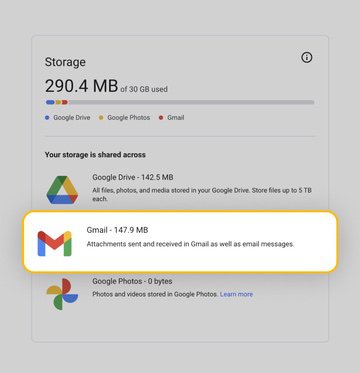
If you discover that your mail is actually not taking up a significant portion of your storage, then you should shift your attention to Google Drive and Google Photos. A single large Google Drive file or a long video automatically uploaded from your smartphone by Google Photos can easily rob you of several gigabytes of storage space that you would much rather use for mail.
Okay, so let’s assume that Gmail is, indeed, taking up most of your storage. In that case, you could simply purchase additional storage space, but you would risk ending up in the same situation again in no time. Instead, you should address the core cause of the issue by learning how to delete emails with large attachments in Gmail.
How to Find Large Emails in Gmail
To efficiently handle deleting large emails in Gmail, you need to be able to display only messages that exceed a certain size. Without this essential skill, you would be forced to examine messages one by one, and that would take an obscenely large amount of time.
The good news is that finding large emails is pretty straightforward:
- Log in to your mail account.
- Make sure your Inbox is selected.
- Click the search options icon on the right side of the search bar.
- Find the Size field, select the “greater than” option, and specify the desired email size.
- Click the Search button.

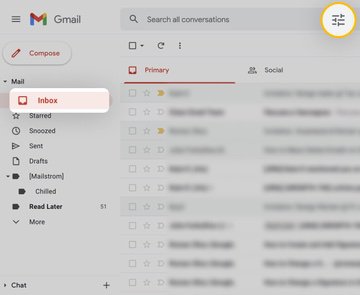
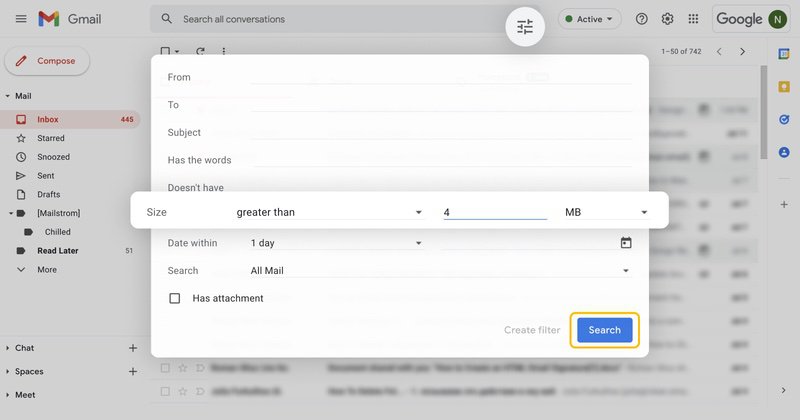
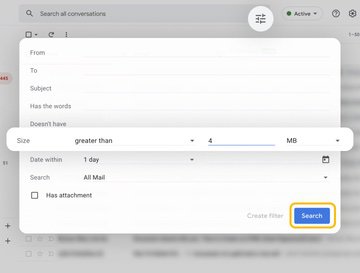
You should now see only messages that are larger than the size you’ve specified, which means you’re ready to learn how to delete large Gmail emails. Alternatively, you can sort Gmail by size directly by typing “larger:5M” (feel free to replace 5 with any number you want) into the search bar.
How to Delete Large Emails in Gmail
Once you’ve successfully found all large messages that are robbing you of precious storage space, you can follow these instructions, which explain how to delete large-size messages from Gmail:
- Click the checkbox located above the found emails (on the left side) to select them all.
- If there are more than 50 messages that match your search, then you also need to click the “Select all conversations that match this search” option.
- Click the Delete button to move all selected messages into the Trash folder.
- Confirm the bulk action by clicking OK in the pop-up window.
- Open the Trash folder, select all emails located there, and click Delete forever. Alternatively, you can click the Empty Trash now option to permanently remove them.
- Confirm the permanent deletion of all messages in Trash by clicking OK in the pop-up window.

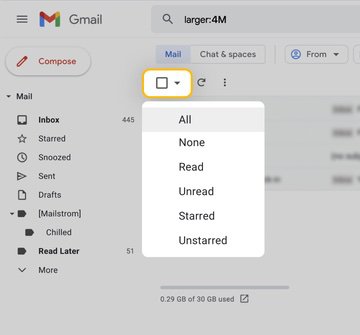

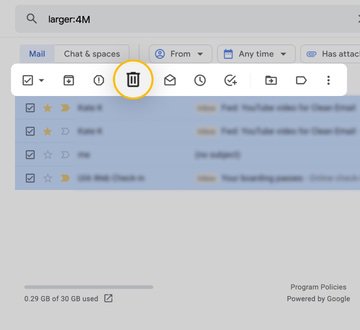

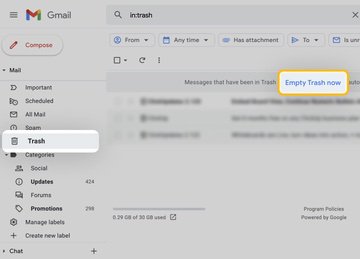
⚠️ Keep in mind that permanently deleted messages can’t be recovered (read more about how to recover deleted emails from Gmail), so take the time to double-check if all emails in the Trash folder can be safely deleted.
Easily Delete Large Emails in Gmail with Clean Email
As you may have noticed, deleting large mail through the native Gmail interface can be a cumbersome task, requiring numerous actions and repeated confirmations of your decisions. What if there was a way to delete large emails in bulk, quickly, and with just a few clicks? The Clean Email app offers you this convenience.
Here’s how simple it is to delete all emails larger than a certain size with Clean Email:
- Visit https://app.clean.email/ and sign up with your email account.
- Navigate to All Mail or your Inbox and use the Large Mail filter to view all messages larger than 10 MB or any other size you set.
- Apply additional filters and sorting options as needed. For example, you can choose to display the newest messages at the top, or sort emails by size or by the number of messages from a sender.
- Select messages or email groups you wish to delete.
- Click the Trash button on the blue action panel.
- Confirm your action to send the emails to the Trash folder.
- To permanently delete messages, select the Delete option on the action panel and confirm the permanent removal from your inbox.
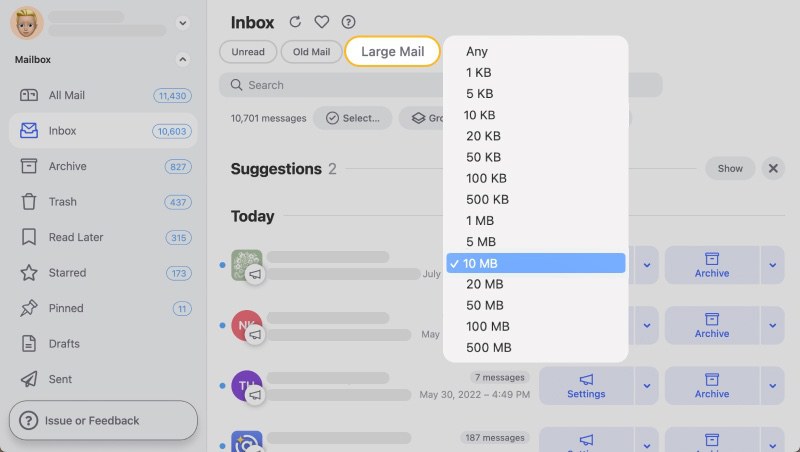
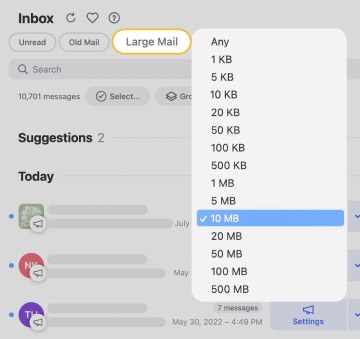
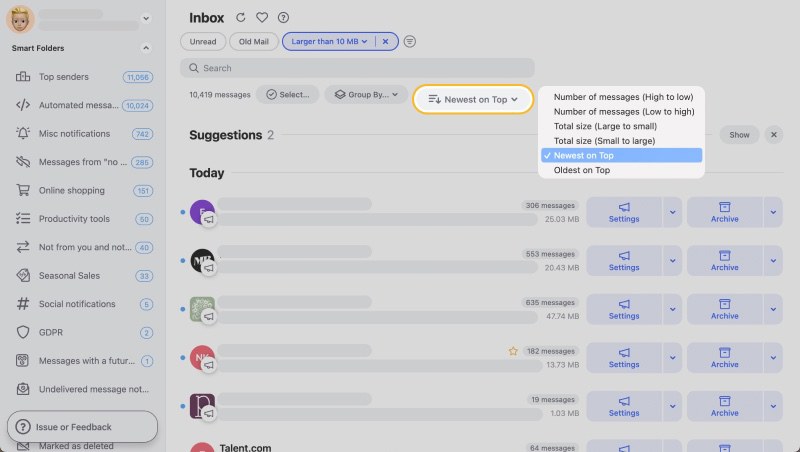
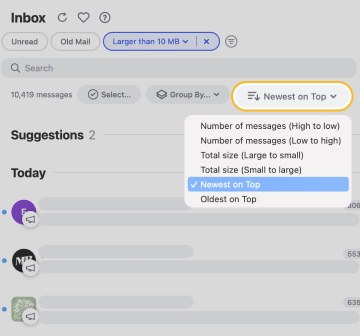

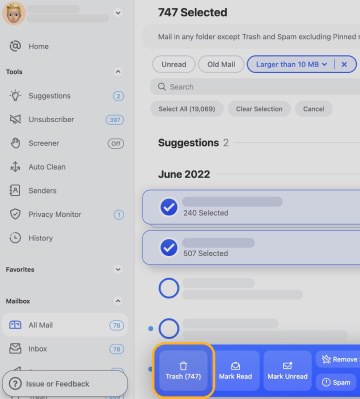
⚠️ Important: Remember, messages permanently deleted on Clean Email cannot be recovered, similar to Gmail.
Moving forward, the Cleaning Suggestions tool will prove to be invaluable. These suggestions are based on similar messages you have previously managed or on those frequently addressed by other Clean Email users.
What's particularly useful is that they are automatically sorted by the number of messages from each sender. This allows you to prioritize actions for the most active senders first. Here, you can Trash, permanently Delete, or apply other actions to these message groups.
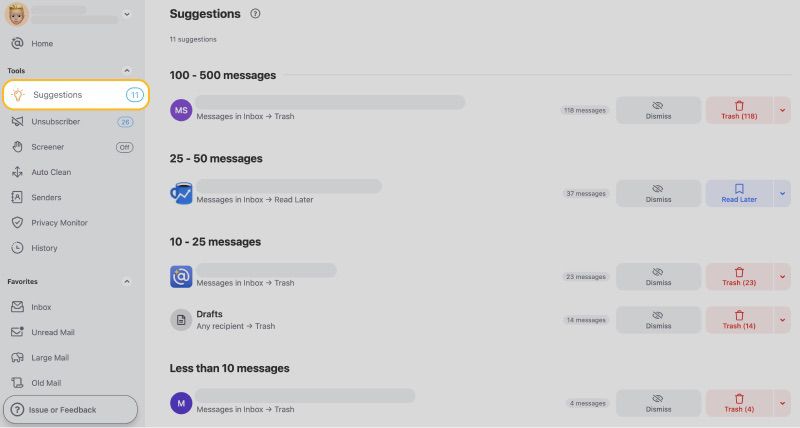

Another feature that helps you manage large emails and the most active senders is Smart Folders. These are 33 predefined filters applied to your inbox, grouping messages that match a common set of parameters.
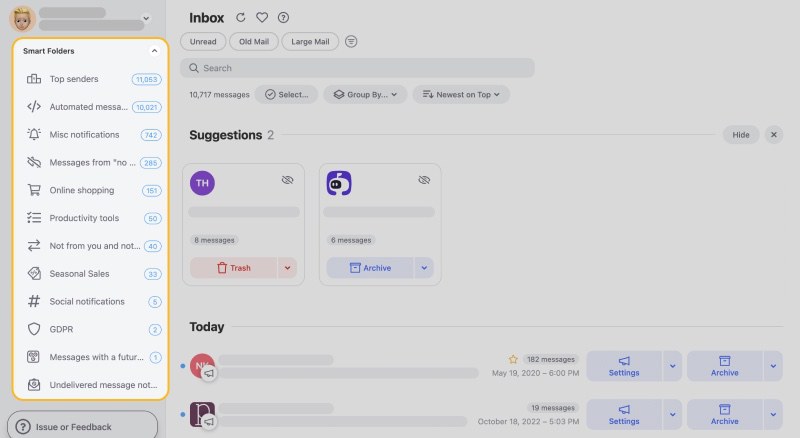
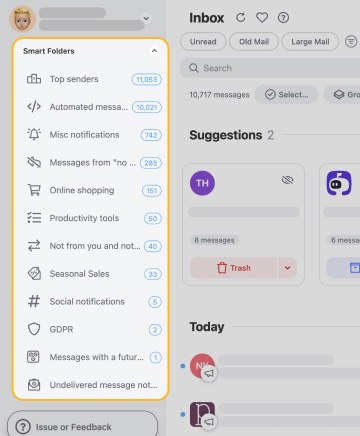
You can add your preferred folders to Favorites by clicking the blue heart icon next to the Smart Folder name. Then, access them from the Favorites section on the left panel.
For your convenience, the Large Mail filter, which filters emails larger than 1 MB in your Inbox, is automatically added to Favorites by default in the Clean Email app. You can configure this filter, or any other, and save your custom settings to Favorites as well.
Additionally, you can set Auto Clean rules to automatically delete old large emails, so you don't have to manually clean them every time. Go to the Auto Clean section on the left panel, click the plus button at the top, and set your rule by enabling the Old Mail and Large Mail filters.
Finally, the Unsubscriber feature can be used to put an end to unwanted mailings and newsletters, preventing your inbox from getting filled with large emails again.

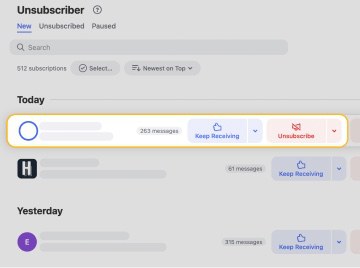
As a trustworthy third-party email organizer, Clean Email is committed to the security and privacy of its users, and it doesn’t keep, sell, or analyze user data for any purposes beyond providing its publicly advertised features.
Tips to Prevent Your Gmail Storage from Running Out
Besides learning how to delete emails with attachments in Gmail, there are several other things you can do to prevent your Gmail storage from running out:
- Delete old emails: To free up space, clear out the outdated mail and delete large attachments Gmail has stored over time. There are several ways how to delete old emails in Gmail, so choose the one you prefer. As mentioned earlier, you can easily manage them through Clean Email and even set automatic rules to have the app delete the old mail on your behalf.
- Delete unnecessary emails: Deleting unwanted messages as soon as they land in your inbox is an essential inbox management practice, so you should learn how to delete all promotions emails in Gmail efficiently using Gmail’s native features and third-party tools.
- Keep the Spam folder empty: Messages that end up in the Spam folder are by definition worthless, so don’t hesitate to get rid of them whenever they start to pile up. Of course, a legitimate email may end up in the Spam folder by accident, so don’t click the Delete button before checking.
- Clean Google Drive and Photos: As we’ve already explained, the Gmail storage space limit is shared across Gmail, Google Drive, and Google Photos, which is why you should regularly clean all three of these services.
- Use file hosting services: If you regularly send large files via email, then your Sent folder is guaranteed to take up a lot of storage space. To make it more compact, you should use third-party file hosting services whenever appropriate and send only text links.
With these simple tips, it should take you a very long time to run out of free Gmail storage space. To effortlessly implement them in practice, you can use a third-party email organizer like Clean Email.
How to Delete Large Emails in Gmail - FAQs
How do I bulk delete Gmail attachments?
You can quickly filter out large emails using a third-party tool like Clean Email and then delete them in bulk:
1. Connect Clean Email to your Gmail inbox.
2. Use the “Large Mail” filter to see all messages that are larger than the size you choose.
3. Select the messages from the given list and click the Trash button.
Can I just delete attachments from Gmail?
Unfortunately, there’s no Gmail delete attachments option that you could use to delete only email attachments. You can, however, display only emails that exceed a certain size, knowing that only messages with attachments are usually larger than several megabytes.
How do I find large emails in Gmail?
To find them, you need to create a custom search filter:
1. Click the settings icon on the right side of the search bar.
2. Find the “Size” field, select the “greater than” option, and specify the desired email size.
3. Click the “Search” button.
Can Gmail delete large emails automatically?
Gmail cannot automatically delete large emails on its own, but you can set a rule in Clean Email to manage and delete them for you.
How can Gmail delete attachments?
To permanently delete attachments (and the messages they were attached to), you need to: Move them to “Trash” → Open the “Trash” folder → Select all emails inside and click the “Delete forever” button.


